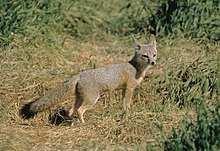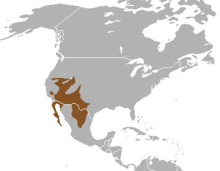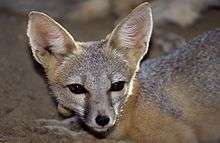Kit fox
The kit fox (Vulpes macrotis) is a fox species of North America. Its range is primarily in the Southwestern United States and northern and central Mexico. Some mammalogists classify it as conspecific with the swift fox, V. velox, but molecular systematics imply that the two species are distinct. It has also been called an American Fennec fox due to its large ears.[3]
| Kit fox[1] | |
|---|---|
 | |
| Male San Joaquin kit fox | |
| Scientific classification | |
| Kingdom: | Animalia |
| Phylum: | Chordata |
| Class: | Mammalia |
| Order: | Carnivora |
| Family: | Canidae |
| Genus: | Vulpes |
| Species: | V. macrotis |
| Binomial name | |
| Vulpes macrotis Merriam, 1888 | |
 | |
| Distribution of the kit fox | |
| Synonyms | |
| |
Range
The northernmost part of its range is the arid interior of Oregon. Its eastern limit is southwestern Colorado. It can be found south through Nevada, Utah, southeastern California, Arizona, New Mexico, and into western Texas.[4]
Subspecies

The endangered San Joaquin kit fox (Vulpes macrotis mutica) was formerly very common in the San Joaquin Valley and through much of Central California. Its 1990 population was estimated to be 7,000. This subspecies is still endangered, after nearly 50 years of being on the Endangered Species List. Officially this subspecies was listed March 3, 1967.[5] On September 26, 2007, Wildlands Inc. announced the designation of the 684 acre (277 ha) Deadman Creek Conservation Bank, which is intended specifically to protect habitat of the San Joaquin kit fox.[6] However, the population continues to decline mostly due to heavy habitat loss. Other factors include competition from red foxes, and the extermination of the wolf from California has left the coyote as the dominant meso-predator in kit fox territory, bringing an imbalance in ecosystem relationships.
Appearance
The kit fox is one of the smallest species of the family Canidae found in North America (except for specially bred domestic dog breeds like teacup Yorkshire.) It has large ears, between 71 and 95 mm (2.8 and 3.7 in), that help the fox lower its body temperature and give it exceptional hearing (much like those of the fennec fox). This species exhibits sexual dimorphism, with the male being slightly larger. The average species weight is between 1.6 and 2.7 kg (3.5 and 6.0 lb). The body length is 455 to 535 mm (17.9 to 21.1 in). The tail adds another 250–340 mm (9.8–13.4 in) to its length.[4]
It usually has a gray coat, with rusty tones, and a black tip to its tail. Unlike the gray fox, it has no stripe along the length of its tail. Its color ranges from yellow to gray, and the back is usually darker than the majority of its coat; its belly and inner ears are usually lighter. It has distinct dark patches around the nose.[4]
Diet
The kit fox is mostly a nocturnal[7] animal, but sometimes ventures out of its den during the day. It usually goes out to hunt shortly after sunset, mostly eating small animals such as kangaroo rats, cottontail rabbits, black-tailed jackrabbits (Lepus californicus), meadow voles, hares, prairie dogs, insects, lizards, snakes, fish, and ground-dwelling birds. It will scavenge carrion. While primarily carnivorous, if food is scarce, it has been known to eat tomatoes (Lycopersicon esculentum), cactus fruits (Carnegiea gigantea) and other fruits. Different kit fox families can occupy the same hunting grounds, but do not generally go hunting at the same time.[4]
The Kit Fox experiences a very interesting, but rare, tooth malformation that causes Bigeminy: a heart rhythm problem. This is caused by the fusion of a maxillary third premolar tooth and an adjoining supernumerary tooth which makes a single tooth with two cusps and three roots.
Habitat
Kit foxes favor arid climates, such as desert scrub, chaparral, and grasslands. Good examples of common habitats are sagebrush Artemisia tridentata and saltbrush Atriplex polycarpa. They can be found in urban and agricultural areas, too. They are found at elevations of 400 to 1,900 meters (1,300 to 6,200 ft) above sea level.[4]
Mating
The kit fox is a socially monogamous species.[8] Male and female kit foxes usually establish monogamous mating pairs during October and November. Polygamous mating relationships have been observed. Pairs can change year to year. They mate from December to February, when they use larger family dens. Litters are born throughout March and April, usually containing one to seven pups, and average four pups. The gestation is 49 to 55 days. Pups do not leave the den until they are four weeks old. They are weaned after about eight weeks and become independent at five to six months old. They become sexually mature at 10 months. Both parents take part in raising and protecting their young. The average lifespan of a wild kit fox is 5.5 years. In captivity, they can live 12 years. One Californian study of 144 kit fox pups showed a 74% mortality rate in pups within the first year.[4][9]
References
- Wozencraft, W.C. (2005). "Order Carnivora". In Wilson, D.E.; Reeder, D.M (eds.). Mammal Species of the World: A Taxonomic and Geographic Reference (3rd ed.). Johns Hopkins University Press. pp. 532–628. ISBN 978-0-8018-8221-0. OCLC 62265494.
- IUCN SCC Canid Specialist Group (North America Regional Section) (2008). "Vulpes macrotis". IUCN Red List of Threatened Species. 2008. Retrieved 22 March 2009.CS1 maint: ref=harv (link) Database entry includes a brief justification of why this species is of least concern
- Mercure, Alan; Ralls, Katherine; Koepfli, Klaus P.; Wayne, Robert K. (1993). "Genetic Subdivisions among Small Canids: Mitochondrial DNA Differentiation of Swift, Kit, and Arctic Foxes". Evolution. 47 (5): 1313–1328. doi:10.2307/2410150. ISSN 0014-3820. JSTOR 2410150. PMID 28564903.
- ADW: Vulpes macrotis: Information. Animaldiversity.ummz.umich.edu (2008-04-05). Retrieved on 2011-09-16.
- http://ecos.fws.gov/speciesProfile/profile/speciesProfile.action?spcode=A006
- Kit fox Gets Some Protection, In California, Environmental News Network, September 27, 2007
- "Kit Fox". Digital Desert. Retrieved 2014-07-16.
- Ralls, Katherine, Brian Cypher, and Linda K. Spiegel. "Social monogamy in kit foxes: formation, association, duration, and dissolution of mated pairs." Journal of Mammalogy 88.6 (2007): 1439-1446.
- "Kit Fox (Vulpes macrotis): A Technical Conservation Assessment", 2006
10. Vieira, J. L., & Có, M. A. (1997). Dental and Temporomandibular Joint Pathology of the Kit Fox (Vulpes macrotis) Author links open overlay panel. Eletrônica De Potência,2(1), 35–42. doi:10.18618/rep.1997.1.035042
External links
| Wikimedia Commons has media related to Vulpes macrotis. |
